Previously unknown bacterial communities responsible for recurrent urinary tract infections in postmenopausal women

Researchers at The University of Texas (UT) at Dallas and UT Southwestern Medical Center have identified several species of bacteria that form bacterial communities responsible for recurrent urinary tract infections (RUTIs) in postmenopausal women.1
Although urinary tract infection (UTI) is one of the most common indications for antibiotic prescription in older adults, the recurrence rate is high – ranging from 19% to 36% in premenopausal women to 55% in postmenopausal women.1 While sexual intercourse and a previous UTI are risk factors for RUTIs in premenopausal women, incontinence, presence of residual urine volume, and presence of a cystocele are the factors commonly associated with RUTIs in postmenopausal women.2 Advanced age also predisposes women to RUTIs – with 10% to 15% of women over the age of 60 being affected.1
The primary pathogen involved in most UTIs, including RUTIs, is uropathogenic Escherichia coli (UPEC); other common causative pathogens include Klebsiella pneumoniae, Staphylococcus spp, Enterococcus faecalis, Group B Streptococcus, Proteus mirabilis, Pseudomonas aeruginosa, and Candida spp.1 The UT study aimed to investigate pathogenic mechanisms and immune responses related to RUTIs. It represents the first systematic analysis of urine and bladder biopsies from postmenopausal women. The study subjects (n=14) had undergone cystoscopy with fulguration of trigonitis – a procedure for the treatment of antibiotic-refractory RUTI.1
Researchers detected the expected uropathogens in the urine samples, including E. coli, K. pneumoniae, and E. faecalis.1 However, in biopsied tissue of the patients, a diverse mixture of bacterial species were detected including the common uropathogens E. coli, K. pneumoniae, and S. hominis, as well as three Bacillus species not typically associated with UTIs (Bacillus firmus, Brevibacillus laterosporus, and Paenibacillus spp).1 These bacterial communities (ranging from a single bacterium to communities of up to 25 bacteria) were found to be located in many layers of the bladder wall, and were proportionally enriched in the sub-urothelial, mesenchymal regions of the bladder biopsies.
Chronic inflammation was observed in all patient biopsies, and plasma B cells were found ubiquitously in these tissues – suggesting an active humoral adaptive immune response.1 Squamous metaplasia was also observed in the urothelium, indicating chronic mucosal irritation attributable to cystitis associated with RUTI.
This study provides insights into the pathogenic mechanism of UPEC in forming intracellular bacterial communities (IBCs) within the superficial cells of the bladder wall, and the antibiotic resistance of the bacteria within the IBCs.1 Besides, the findings of the study also suggests the reactivation of quiescent intracellular reservoirs (QIRs) that serve as the seed for re-infection. Therefore, the IBC-QIR model explains the persistence of uropathogens in the bladder, host immune responses, and antibiotic resistance.
The researchers confirmed that bacteria form communities within the bladder wall of patients with RUTI, and established that the humoral adaptive immune response plays an active role in RUTIs.
References
- De Nisco NJ, et al. J Mol Biol 2019 Apr 17. doi: 10.1016/j.jmb.2019.04.008. [Epub ahead of print]
- Glover M, et al. Urol Sci 2014;25:1-8.










